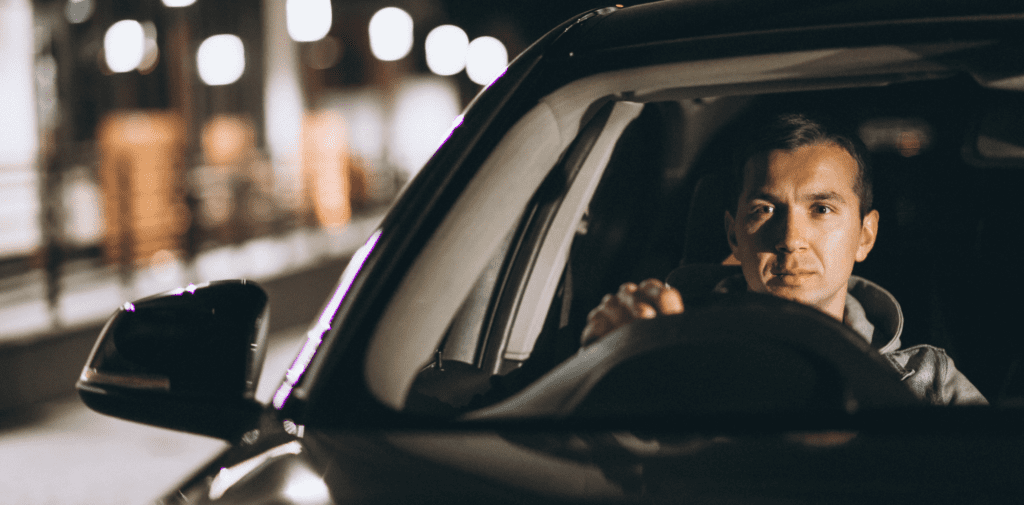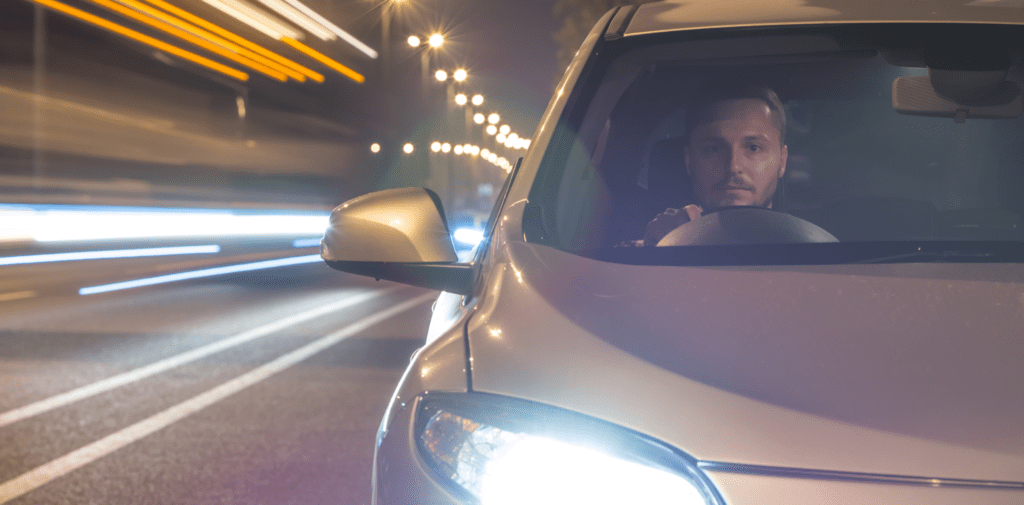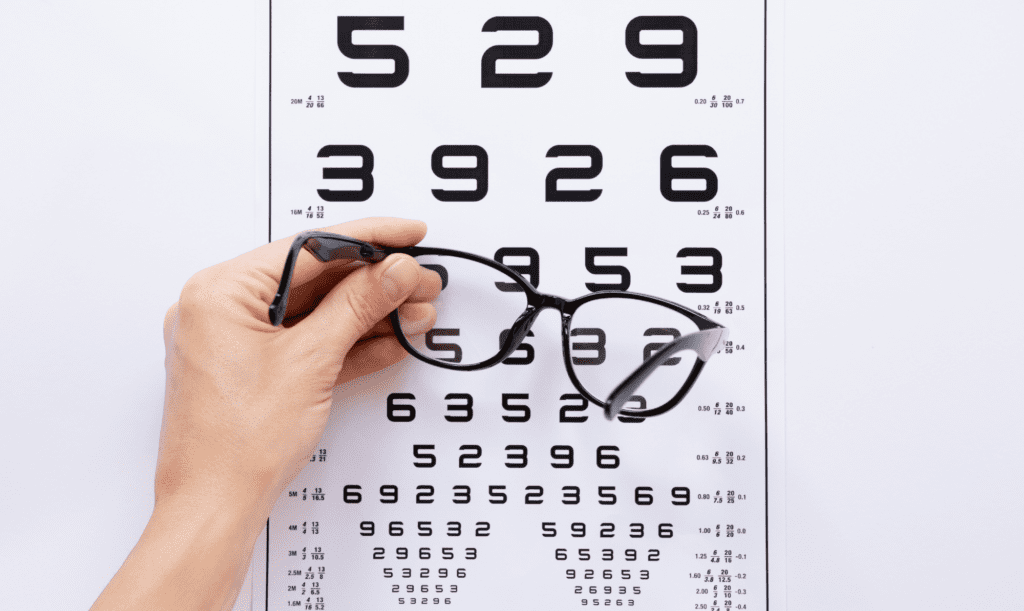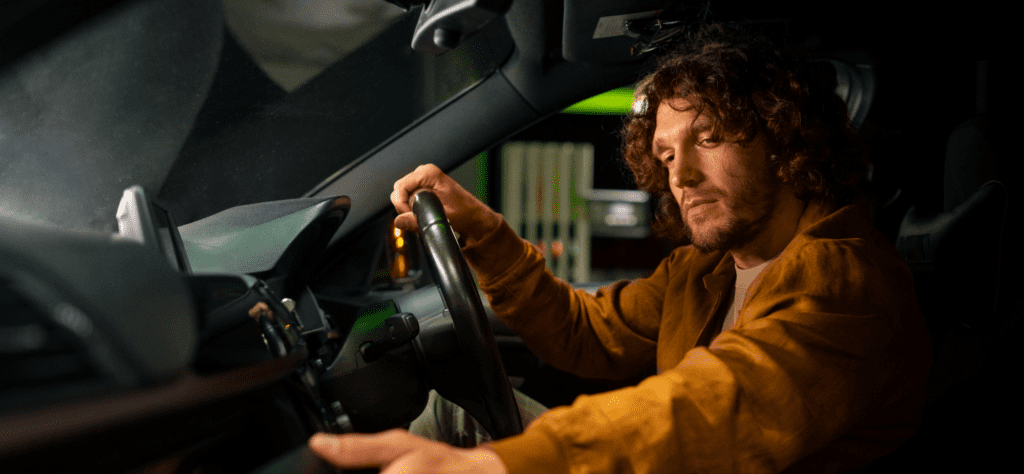
Driving at night presents a unique set of challenges that require increased awareness and caution.
For UK drivers, navigating the roads after dark necessitates:
- Understanding how to use your lights appropriately
- Manage glare from oncoming vehicles
- Adopt safe driving practices
This comprehensive guide will equip you with the knowledge needed to stay safe while driving at night.
Use Your Lights Appropriately
Using your lights correctly is crucial for safe night driving. Proper use of headlights ensures you can see the road ahead and be seen by other road users.

Understanding Different Light Settings
Your vehicle is equipped with various light settings, each serving a specific purpose. Familiarising yourself with these settings can greatly improve your night driving experience.
-
Dipped Beam Headlights: These are your standard headlights, used for normal night-time driving. They provide sufficient illumination for you to see the road ahead without blinding other drivers.
-
Full Beam Headlights: Also known as high beams, these lights offer maximum illumination, allowing you to see further down the road. They should be used sparingly to avoid dazzling other drivers.
-
Fog Lights: These are designed for use in foggy conditions, where visibility is significantly reduced. They are positioned lower on the vehicle to cut through the fog without reflecting back into your eyes.
-
Daytime Running Lights (DRLs): While not specifically for night-time use, DRLs automatically turn on when the engine starts, enhancing your vehicle’s visibility during the day.
Understanding when and how to use these different light settings can make a substantial difference in your night driving safety.
When to Use Full Beams
Full beams are extremely useful on dark, unlit roads where visibility is limited. They can help you spot potential hazards much sooner than dipped beams. However, it is essential to know when to switch them on and off:
-
Use full beams when driving on country roads with no street lighting. This will give you a clearer view of the road and any potential hazards.
-
Switch back to dipped beams when you see an oncoming vehicle. Full beams can temporarily blind other drivers, making it dangerous for them.
-
Dim your lights when approaching another vehicle from behind. Full beams in the rear-view mirror can be just as dazzling as oncoming headlights.
-
Be mindful of reflective signs. Full beams can cause intense glare from reflective road signs, which can be distracting.
Using full beams appropriately ensures you maintain maximum visibility without compromising the safety of other road users.
Avoiding Dazzling Other Drivers
Dazzling other drivers is a significant hazard at night. Here are some tips to avoid causing discomfort or danger to others:
-
Adjust your headlights properly. Misaligned headlights can point upwards or to the side, directly into the eyes of other drivers. Regularly check your headlight alignment and adjust them as needed.
-
Use dipped beams in built-up areas and when following another vehicle. This reduces the risk of dazzling other drivers.
-
Be considerate with your full beams. Switch to dipped beams as soon as you see the headlights or taillights of another vehicle.
-
Check your mirrors. Ensure your rear-view mirror is set to the night mode (often a small lever on the bottom) to reduce glare from vehicles behind you.
-
Clean your headlights regularly. Dirt and grime can scatter the light, reducing effectiveness and increasing glare.
Don’t Stare at Oncoming Vehicles
One of the most common issues at night is being temporarily blinded by the headlights of oncoming vehicles. Learning how to manage this glare and protect your vision is crucial.

Managing Glare from Oncoming Headlights
Glare from oncoming headlights can be blinding and dangerous. Here are some techniques to manage it effectively:
-
Avoid direct eye contact with the headlights of oncoming vehicles. Instead, focus on the left-hand side of the road to stay within your lane.
-
Use the road markings as a guide. Keeping your eyes on the lane markers can help you maintain your direction without being distracted by oncoming headlights.
-
Adjust your mirrors to the night setting to reduce glare from vehicles behind you.
-
Wear anti-reflective glasses if you wear glasses. These can help reduce glare from headlights and improve your overall night vision.
Techniques to Avoid Eye Strain
Driving at night can cause significant eye strain due to reduced light and the constant need to adjust to changing light levels. Here are some techniques to minimise eye strain:
-
Keep your windscreen clean. A dirty windscreen can scatter light and increase glare, making it harder for your eyes to focus.
-
Take regular breaks. If you’re on a long journey, stop every couple of hours to rest your eyes and stretch your legs.
-
Maintain a safe distance from the vehicle in front. This not only improves safety but also reduces the intensity of headlights shining directly into your eyes.
-
Use the car’s interior lights sparingly. Bright interior lights can reduce your ability to see outside the vehicle. If you need to use a map or check something, use a dim, focused light.
-
Keep your dashboard lights dim. Bright dashboard lights can be distracting and make it harder to see outside. Adjust them to a comfortable level that doesn’t interfere with your night vision.
Safe Driving Practices at Night
Adopting safe driving practices is essential for navigating the roads safely at night. Here are some important tips:
-
Slow down. Reduced visibility means you have less time to react to hazards. Driving at a slower speed gives you more time to see and respond to potential dangers.
-
Increase your following distance. Leave a larger gap between you and the vehicle in front to give yourself more time to react.
-
Stay alert. Fatigue can set in quickly at night. Be aware of the signs of drowsiness, such as frequent yawning, heavy eyelids, and drifting from your lane. If you feel tired, take a break.
-
Look out for wildlife. Animals are more active at night and can appear suddenly in your path. Be particularly vigilant in rural areas.
-
Be cautious at junctions. Other drivers may have difficulty seeing you, so take extra care when approaching and crossing junctions.
-
Use your horn sparingly**. If you need to warn another driver or pedestrian of your presence, use your horn judiciously to avoid startling them.
-
Keep your vehicle well-maintained. Regularly check your lights, brakes, and tyres to ensure they are in good working condition. Proper maintenance is crucial for safe night driving.
Keep Windows Clean
Maintaining clear windows is vital for optimal visibility while driving at night. Dirty or foggy windows can significantly impair your ability to see the road and potential hazards.
Importance of Clear Windows for Visibility
Clear windows are essential for several reasons:
-
Maximising visibility: Clean windows provide a clear view of the road, making it easier to spot other vehicles, pedestrians, and obstacles.
-
Reducing glare: Dirt and grime on windows can scatter light, increasing glare from oncoming headlights and streetlights, which can be blinding and dangerous.
-
Enhancing the effectiveness of headlights: Clean windows allow your headlights to illuminate the road more effectively, improving your ability to see at night.
Tips for Cleaning Windows
Keeping your windows clean doesn’t require much effort but makes a significant difference in visibility. Here are some tips:
-
Use a quality glass cleaner: A good automotive glass cleaner can remove grime without leaving streaks. Apply it with a microfibre cloth for the best results.
-
Clean both inside and outside: It’s important to clean the interior surfaces of your windows as well as the exterior. Dust and smudges on the inside can be just as distracting as dirt on the outside.
-
Wipe in a circular motion: When cleaning, use a circular motion to avoid streaks and ensure a thorough clean.
-
Don’t forget the mirrors: Clean your side and rear-view mirrors regularly. Clear mirrors are crucial for checking your surroundings, especially at night.
-
Regular maintenance: Make window cleaning part of your regular vehicle maintenance routine to ensure they stay clear.

Preventing Foggy Windows
Foggy windows can be a common issue, especially during cooler weather. Here are some strategies to prevent and deal with foggy windows:
-
Use the defroster: Most vehicles have a defroster setting that directs warm air onto the windscreen to clear fog. Use this setting before you start driving and as needed.
-
Air conditioning: Running the air conditioner can help reduce humidity inside the vehicle, which in turn helps prevent fogging.
-
Crack a window: Allowing a small amount of outside air into the car can balance the humidity levels and prevent fogging.
-
Anti-fog treatments: There are various anti-fog sprays and wipes available that can be applied to your windows to help prevent them from fogging up.
-
Keep windows clean: Clean windows are less likely to fog up. Ensure you regularly clean the interior surfaces to reduce the chances of fogging.
Watch Out for Children, Cyclists, and Animals
Driving at night requires heightened vigilance, particularly for vulnerable road users like children, cyclists, and animals.

Recognising and Reacting to Pedestrians
Pedestrians are often less visible at night, making it crucial to stay alert and take extra precautions:
-
Slow down in residential areas: Children and other pedestrians are more likely to be present in residential areas. Reduce your speed to give yourself more time to react.
-
Use your peripheral vision: Keep an eye on the sides of the road, as pedestrians might be waiting to cross or walking along the roadside.
-
Watch for movement: Look for signs of movement, such as the reflection of your headlights in a pedestrian’s clothing or the movement of shadows.
-
Be cautious near schools and parks: These areas are likely to have more pedestrians, even after dark. Be particularly vigilant when driving near them.
-
Make eye contact: If you see a pedestrian waiting to cross, try to make eye contact. This helps ensure they are aware of your presence and you of theirs.
Safely Sharing the Road with Cyclists
Cyclists can be hard to spot at night, and it’s important to share the road with them safely:
-
Use your dipped beams: When approaching a cyclist, switch to dipped beams to avoid dazzling them.
-
Give plenty of space: Leave a safe distance when passing a cyclist, at least 1.5 metres, to ensure their safety.
-
Watch for hand signals: Cyclists may indicate their intentions with hand signals. Be attentive to these signals so you can anticipate their movements.
-
Slow down: Reduce your speed when you see a cyclist, especially if the road is narrow or winding.
-
Check for cyclists at junctions: Always check your mirrors and blind spots for cyclists before turning or changing lanes.
Being Alert for Animals on the Road
Animals can pose a significant hazard at night, particularly in rural areas. Here are some tips to stay alert and safe:
-
Watch for warning signs: Pay attention to road signs indicating areas where animals frequently cross. Slow down and be extra cautious in these zones.
-
Use your full beams: On dark rural roads, use your full beams to spot animals from a distance. Just remember to switch to dipped beams when there’s oncoming traffic.
-
Look for reflections: The eyes of animals often reflect light, making them visible from a distance. Watch for these reflections at the roadside.
-
Be cautious during peak activity times: Dawn and dusk are times when animals are most active. Be extra vigilant during these periods.
-
Don’t swerve suddenly: If an animal appears in your path, try to brake rather than swerving, which can lead to a loss of control or a collision with another vehicle.
Get Your Eyes Tested
Regular eye tests are crucial for maintaining good vision and ensuring safety while driving at night. Many vision problems can develop gradually, so routine check-ups are essential.

Importance of Regular Eye Tests
-
Detecting issues early: Regular eye tests can identify vision problems before they become severe. Early detection allows for timely treatment and management.
-
Ensuring legal compliance: Drivers in the UK are required to meet certain vision standards. Regular eye tests ensure you remain compliant with these requirements.
-
Improving night vision: Some eye conditions, like cataracts or uncorrected refractive errors, can worsen night vision. Regular tests can help diagnose and treat these issues.
-
Optimising eye health: Eye tests can also detect other health conditions, such as diabetes and high blood pressure, which can affect your vision.
Recognising Signs of Vision Problems
Being aware of the signs of vision problems can help you seek prompt medical attention. Look out for:
-
Difficulty seeing at night: Struggling to see road signs or other vehicles in low light can indicate a problem.
-
Increased glare: If headlights from oncoming traffic cause excessive glare or halos, it may be a sign of an issue like cataracts.
-
Frequent headaches: Regular headaches, particularly after driving, can indicate eye strain or an uncorrected vision problem.
-
Blurry vision: Any blurriness, whether constant or intermittent, should be evaluated by an optometrist.
-
Eye fatigue: Persistent eye strain or fatigue, especially after night driving, may suggest a vision issue.
Choosing the Right Eyewear for Night Driving
Selecting the appropriate eyewear can significantly enhance your night driving experience:
-
Anti-reflective lenses: These lenses reduce glare from headlights and streetlights, improving clarity and comfort.
-
Yellow-tinted glasses: Some drivers find yellow-tinted lenses helpful for reducing glare and improving contrast at night.
-
Prescription glasses: Ensure your prescription is up-to-date. Even a slight change in your vision can impact night driving.
-
Polarised lenses: While polarised lenses are excellent for reducing glare during the day, they may not be suitable for night driving as they can reduce overall visibility.
-
Fit and comfort: Choose glasses that fit well and are comfortable to wear for extended periods, as discomfort can be distracting.
Don’t Get Behind the Wheel When Tired
Driving while tired is extremely dangerous and significantly increases the risk of accidents. It’s essential to recognise the signs of fatigue and take appropriate measures to stay safe.

Recognising Signs of Fatigue
Understanding and acknowledging the signs of fatigue can prevent you from driving in a dangerous state:
-
Yawning frequently: Persistent yawning is a clear indicator of tiredness.
-
Difficulty focusing: Struggling to keep your eyes open or maintain focus on the road is a serious sign of fatigue.
-
Memory lapses: Not remembering the last few miles driven is a warning sign that you need rest.
-
Drifting in your lane: If you find yourself drifting between lanes or hitting the rumble strips, it’s time to pull over.
-
Heavy eyelids: Feeling your eyelids becoming heavy and hard to keep open is a direct sign of severe fatigue.
Tips for Staying Awake and Alert
To stay awake and alert while driving at night, consider these tips:
-
Take regular breaks: Stop every two hours for at least 15 minutes to rest and stretch your legs.
-
Drink caffeine: Coffee or other caffeinated beverages can help you stay awake, but remember that the effects are temporary.
-
Stay hydrated: Dehydration can contribute to fatigue, so keep a bottle of water handy.
-
Listen to engaging content: Play lively music, podcasts, or audiobooks to keep your mind active.
-
Avoid heavy meals: Eating a large meal before driving can make you feel sluggish. Opt for lighter snacks instead.
-
Use fresh air: Open a window or adjust the air conditioning to keep cool, as a warm and stuffy car can increase drowsiness.
Alternatives to Driving When Tired
If you’re too tired to drive, consider these alternatives:
-
Find a rest area: Pull into a safe rest area or service station to take a short nap.
-
Switch drivers: If you’re travelling with someone else who can drive, take turns behind the wheel.
-
Public transport: Use public transportation if available, allowing you to rest while commuting.
-
Delay your trip: If possible, postpone your journey until you feel more rested and alert.
-
Book a hotel: If you’re on a long trip and feel exhausted, consider stopping overnight at a hotel to get proper rest.
By recognising the importance of eye health and avoiding driving while tired, you can significantly enhance your safety and the safety of others on the road.
These precautions are critical to ensure that you remain alert and capable of handling the unique challenges of night driving.
Hone Your Night-Driving Skills
Driving at night requires a unique set of skills that can be honed through practice and awareness.
To become proficient in night driving, it’s essential to gain experience in various conditions, improve your reaction times, and build confidence.
Practicing in Different Night Conditions
Practicing in different night conditions can significantly enhance your ability to handle diverse scenarios on the road.
Start by driving on well-lit urban roads where streetlights provide ample illumination. This helps you get accustomed to driving in reduced light without the complete darkness of rural roads.
Gradually progress to country roads where lighting is minimal, forcing you to rely more on your vehicle’s headlights.
It’s also beneficial to practice in different weather conditions, such as rain or fog, which can further reduce visibility and increase the difficulty of night driving. These experiences will help you become more adaptable and confident.
Improving Reaction Times
Improving your reaction times is crucial for night driving, where visibility is limited and hazards can appear suddenly.
To enhance your reaction times, ensure you are well-rested before driving. Fatigue can significantly slow your reflexes.
Engage in regular eye exercises that can help maintain sharp vision and quick focus changes.
Keeping your mind active by listening to engaging content, such as music or podcasts, can also prevent drowsiness and improve alertness.
Practice defensive driving techniques, such as maintaining a safe following distance and scanning the road ahead, to give yourself more time to react to potential hazards.
Building Confidence in Night Driving
Building confidence in night driving comes with practice and experience. Start with short trips on familiar roads to build your confidence gradually.
As you become more comfortable, extend your driving to longer journeys and unfamiliar routes.
Pay attention to your surroundings and trust your instincts. Confidence can also be bolstered by ensuring your vehicle is in good working condition, with properly functioning headlights and a clean windscreen for optimal visibility.
Regularly review and follow best practices for night driving to reinforce your skills and knowledge.
Potholes in the Dark
Potholes present a significant hazard, particularly at night when visibility is reduced. Being able to identify and avoid these road hazards is essential for safe driving.
Identifying Road Hazards at Night
Identifying road hazards at night requires keen observation and the effective use of your vehicle’s lights.
Use your dipped beams to illuminate the road ahead without blinding other drivers. Pay close attention to the road surface, looking for shadows and irregularities that might indicate potholes.
Reflective road signs and markings can also provide clues about upcoming road conditions.
Slow down in areas where potholes are likely to be present, such as poorly maintained rural roads or areas with recent heavy rainfall.
Techniques for Avoiding Potholes
To avoid potholes, maintain a safe speed and keep a lookout for any irregularities on the road.
When you spot a pothole, gently steer around it if it’s safe to do so. Avoid sudden swerves which can cause loss of control or accidents.
If avoiding a pothole isn’t possible, slow down as much as you can before you reach it. Hitting a pothole at a lower speed can reduce the risk of damage to your vehicle.
Ensure your tyres are properly inflated, as well-inflated tyres can better absorb the impact of hitting a pothole.
Dealing with Damage from Potholes
If you do hit a pothole, it’s important to check for damage immediately. Pull over to a safe spot and inspect your tyres for any bulges, cuts, or punctures.
Check the alignment of your wheels; hitting a pothole can knock your wheels out of alignment, causing your vehicle to pull to one side.
Listen for unusual noises or vibrations that could indicate damage to your suspension.
If you notice any issues, it’s best to have your vehicle inspected by a professional mechanic as soon as possible to prevent further damage or unsafe driving conditions.
Regular maintenance and prompt repairs can help keep your vehicle in top condition and ready for night driving.
Frequently asked questions
Driving at night is more challenging due to reduced visibility, glare from oncoming headlights, and increased fatigue.
The darkness limits your ability to see hazards in time, requiring more cautious and attentive driving.
To improve visibility, ensure your
- Headlights are clean and properly aligned
- Use your full beams on dark roads when appropriate
- Keep your windscreen clean both inside and out
Use full beams on dark, unlit roads to maximise visibility.
However, switch to dipped beams when you see oncoming vehicles or when driving behind another vehicle to avoid dazzling other drivers.
To avoid dazzling other drivers, use dipped beams in built-up areas and when following another vehicle.
Ensure your headlights are correctly aligned and clean your lights regularly.
If you’re dazzled by oncoming headlights, avoid looking directly at them.
Instead, focus on the left-hand side of the road and use the road markings to guide you.
Reduce glare by:
- Ensuring your windscreen is clean
- Using anti-reflective coatings on your glasses if you wear them
- Adjusting your rear-view mirror to its night setting
Clean windows improve visibility by reducing glare and ensuring you have a clear view of the road.
Dirty windows can scatter light and obscure your vision.
Regular eye tests are recommended at least every two years, or more frequently if you notice any changes in your vision or have difficulty seeing at night.
Signs of fatigue include:
- Frequent yawning
- Difficulty focusing
- Heavy eyelids
- Drifting between lanes
If you experience these, it’s best to rest before continuing your journey.
Stay alert by:
- Taking regular breaks
- Drinking caffeinated beverages
- Staying hydrated
- Engaging with lively music or podcasts
Ensure your vehicle is well-ventilated and avoid heavy meals before driving.
If you encounter a pothole, try to avoid it if it’s safe to do so.
If you can’t, slow down before you reach it to minimise damage. After hitting a pothole, check your tyres and alignment for any signs of damage.
Identify road hazards by:
- Using your dipped beams to illuminate the road ahead
- Looking for shadows and irregularities
- Paying attention to reflective signs and road markings
For night driving, use anti-reflective lenses to reduce glare.
Yellow-tinted glasses can improve contrast, but ensure your prescription is up-to-date for the best vision.
Safely share the road with cyclists by
- Using dipped beams, giving them plenty of space when passing, and watching for hand signals.
- Slow down and check for cyclists at junctions and in your blind spots.
When driving in rural areas:
- Use full beams where appropriate
- Watch for wildlife
- Drive at a reduced speed to account for potential hazards such as potholes or sharp bends.
Always be prepared for sudden appearances of animals or other obstacles.


